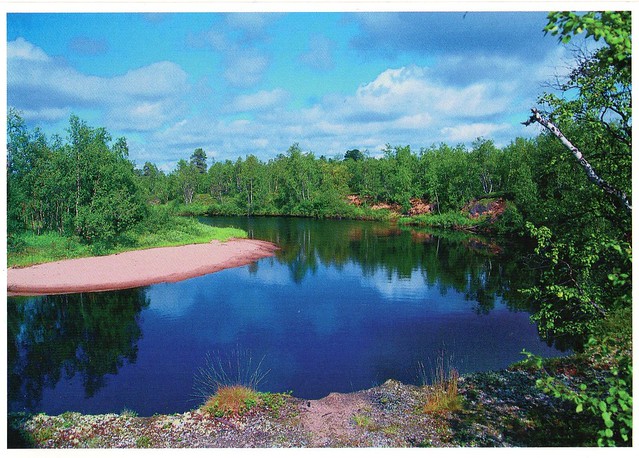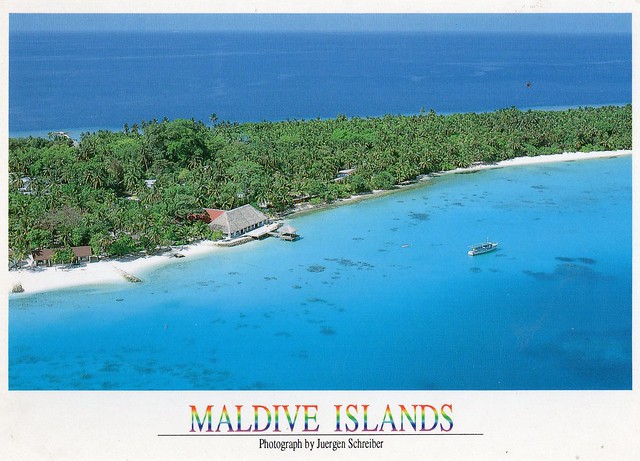Today's last card is from the lovely Sini who keeps surprising me with lots of lovely postcards from her travels. She has visited some amazing places, it's always fascinating to read about her travels.
The cathedral and churches of Echmiatsin and the archaeological remains at Zvartnots graphically illustrate the evolution and development of the Armenian central-domed cross-hall type of church, which exerted a profound influence on architectural and artistic development in the region.
The city of Echmiatsin is located in the Armavir Marz region of Armenia. The settlement has existed since ancient times, as evidenced by Stone, Bronze, and Iron Age archaeological sites located in and near the city. The oldest written information about Echmiatsin refers to the period of the Urartian King Rusa II (685-645 BC). The settlement was mentioned in the Urartian cuneiform inscription by the name of Kuarlini. Life in this Armenian settlement has continued uninterrupted. The town has been called, successively, Artimed, during the rule of Yervandunis (as evidenced by Armenian historian Movses Khorenatsi (5th century AD)), Vardgesavan, and afterwards Vagharshapat, during the age of development under the rule of King Vagharsh I Arshakuni (AD 117-140). The name Echmiatsin was used along with that of Vagharshapat after the adoption of Christianity (AD 301).
The inscribed property is divided into three separate areas: the first area includes the Mother Cathedral of Echmiatsin and St Gayane Church. The area is about 30.2 ha. 18.8 ha belongs to the Mother See of Echmiatsin (the Mother Cathedral and surrounding constructions covering 16.4 ha, the St Gayane Church and surrounding buildings covering 2.0 ha, and the cemetery of the congregation covering 0.4 ha) and 11.4 ha belongs to the community of Echmiatsin City. The second area includes St Hripsime Church and St Shoghakat Church. This area is about 25.3 ha, with 6.2 ha being the territory of St Hripsimeh Church, belonging to the Mother See. The remaining 19.2 ha belongs to the community of Echmiatsin City.
The third area consists of the archaeological site of Zvartnots, with the ruins of the temple, Catholicos Palace and other constructions, and occupies about 18.8 ha.
The religious buildings of Echmiatsin and the archaeological remains at Zvartnots bear witness to the implantation of Christianity in Armenia and to the evolution of a unique Armenian ecclesiastical architecture, which exerted a profound influence on architectural and artistic development in the region. They graphically illustrate the evolution and flowering of the Armenian central-domed cross-hall type of church.
Saturday, 14 July 2018
Palojoki, Lapland, Finland
...and now for something I have been dreaming of recently.. even more so than being on a tropical beach :P I think it has been more since I moved to England that I have learned to appreciate the beauty and the tranquility of the Finnish nature. There's something here that makes me very "homesick". ...and yet England is my home now...
This card is from one of my 'summer card pals', Tua, from last year. I really like that project and have been participating on the Finnish Postcrossing forum on it for years. It doesn't seem too active this year, I'm a little disappointment I must say. It was so much fun last year and I received so many gorgeous postcards such as this from Lapland. The sender of this card lives in a village near this river. It looks so calm and tranquil. It would probably be nice to swim in the river at the moment, too, if you were there now as Lapland has been having a heatwave for a while now as well. Not something you get every year! :o
The stamp is from a set of awesome sauna stamps issued last year. I have a bit of a thing for the sauna and collect postcards relating to it. I have a fairly reasonable collection by now as well. NOTE: the link is not work safe and some of the pictures contain nudity.
This card is from one of my 'summer card pals', Tua, from last year. I really like that project and have been participating on the Finnish Postcrossing forum on it for years. It doesn't seem too active this year, I'm a little disappointment I must say. It was so much fun last year and I received so many gorgeous postcards such as this from Lapland. The sender of this card lives in a village near this river. It looks so calm and tranquil. It would probably be nice to swim in the river at the moment, too, if you were there now as Lapland has been having a heatwave for a while now as well. Not something you get every year! :o
The stamp is from a set of awesome sauna stamps issued last year. I have a bit of a thing for the sauna and collect postcards relating to it. I have a fairly reasonable collection by now as well. NOTE: the link is not work safe and some of the pictures contain nudity.
Greetings from Cyprus
I have picked some predominantly blue cards for today. ...to try and feel a bit cooler myself?? :P This postcard is from a swap with Sandra, she helped in designing this card as well which I think is pretty awesome.
The picture here shows the birthplace of Aphrodite, the ancient Greek goddess of love, beauty, pleasure, and procreation. She is identified with the planet Venus, which is named after the Roman goddess Venus, with whom Aphrodite was extensively syncretized. Aphrodite's major symbols include myrtles, roses, doves, sparrows, and swans.
The picture here shows the birthplace of Aphrodite, the ancient Greek goddess of love, beauty, pleasure, and procreation. She is identified with the planet Venus, which is named after the Roman goddess Venus, with whom Aphrodite was extensively syncretized. Aphrodite's major symbols include myrtles, roses, doves, sparrows, and swans.
Maldives
We have been having a heatwave here in England for... umm.. I can't even remember how long for now, it must be at least three weeks or that what it feels like. I know I shouldn't complain because normally I'm too cold, but it's getting rather uncomfortable when I can't sleep properly at night (even with a fan on in my bedroom and the window open) and I'm constantly tired. If you close your eyes you can almost imagine being in a tropical paradise :p I wouldn't say no to a calm beach like this!
This postcard is from a friend, his mum had a stack of postcards from different places that he found when she passed away... This is one of them. I don't know whether she actually ever visited the Maldives, probably. She was such an amazing woman, I miss her.
The Maldives remained largely unknown to tourists until the early 1970s. Only 185 islands are home to its 300,000 inhabitants. The other islands are used entirely for economic purposes, of which tourism and agriculture are the most dominant. Tourism accounts for 28% of the GDP and more than 60% of the Maldives' foreign exchange receipts. Over 90% of government tax revenue comes from import duties and tourism-related taxes.
This postcard is from a friend, his mum had a stack of postcards from different places that he found when she passed away... This is one of them. I don't know whether she actually ever visited the Maldives, probably. She was such an amazing woman, I miss her.
The Maldives remained largely unknown to tourists until the early 1970s. Only 185 islands are home to its 300,000 inhabitants. The other islands are used entirely for economic purposes, of which tourism and agriculture are the most dominant. Tourism accounts for 28% of the GDP and more than 60% of the Maldives' foreign exchange receipts. Over 90% of government tax revenue comes from import duties and tourism-related taxes.
Thursday, 12 July 2018
Palace and Gardens of Schönbrunn, Austria
One more for today... another swap from last year and also a Unesco card with a Europa stamp and gorgeous special cancellations. :) Thank you so much, Marco!
From the 18th century to 1918, Schönbrunn was the residence of the Habsburg emperors. It was designed by the architects Johann Bernhard Fischer von Erlach and Nicolaus Pacassi and is full of outstanding examples of decorative art. Together with its gardens, the site of the world’s first zoo in 1752, it is a remarkable Baroque ensemble and a perfect example of Gesamtkunstwerk.
.
From the 18th century to 1918, Schönbrunn was the residence of the Habsburg emperors. It was designed by the architects Johann Bernhard Fischer von Erlach and Nicolaus Pacassi and is full of outstanding examples of decorative art. Together with its gardens, the site of the world’s first zoo in 1752, it is a remarkable Baroque ensemble and a perfect example of Gesamtkunstwerk.
.
Guimarães, Portugal
Just a couple of other random cards for today... This one is from a swap from last year. I was actually able to collect some Europa stamps then as the Royal Mail decided to issue one as well and I was able to offer a Europa stamp for swap. This year, once again, the Royal Mail haven't bothered :(
The exceptionally well preserved Historic Centre of Guimarães, located in the northern Portugal district of Braga, is often referred to as the cradle of the Portuguese nationality. The history of Guimarães is closely associated with the creation of the national identity and language of Portugal. The city was the feudal territory of the Portuguese Dukes who declared the independence of Portugal in the mid-12th century.
Founded in the 4th century, Guimarães became the first capital of Portugal in the 12th century. Its historic centre is an extremely well preserved and an authentic example of the evolution of a medieval settlement into a modern town, its rich building typology exemplifying the specific development of Portuguese architecture from the 15th to the 19th centuries through the consistent use of traditional building materials and techniques. This variety of different building types documents the responses to the evolving needs of the community. A particular type of construction developed here in the Middle Ages was used widely in the then Portuguese colonies. It featured a ground floor in granite with a half-timbered structure above, a technology that was transmitted to Portuguese colonies in Africa and the New World, becoming their characteristic feature.
The Historic Centre of Guimarães is distinguished in particular for the integrity of its historically authentic building stock. Examples from the period from 950 to 1498 include the two anchors around which Guimarães initially developed, the castle in the north and the monastic complex in the south. The period from 1498 to 1693 is characterized by noble houses and the development of civic facilities, city squares, etc. While there have been some changes during the modern era, the historic centre of Guimarães has maintained its medieval urban layout. The continuity in traditional technology and the maintenance and gradual change have contributed to an exceptionally harmonious townscape.
The exceptionally well preserved Historic Centre of Guimarães, located in the northern Portugal district of Braga, is often referred to as the cradle of the Portuguese nationality. The history of Guimarães is closely associated with the creation of the national identity and language of Portugal. The city was the feudal territory of the Portuguese Dukes who declared the independence of Portugal in the mid-12th century.
Founded in the 4th century, Guimarães became the first capital of Portugal in the 12th century. Its historic centre is an extremely well preserved and an authentic example of the evolution of a medieval settlement into a modern town, its rich building typology exemplifying the specific development of Portuguese architecture from the 15th to the 19th centuries through the consistent use of traditional building materials and techniques. This variety of different building types documents the responses to the evolving needs of the community. A particular type of construction developed here in the Middle Ages was used widely in the then Portuguese colonies. It featured a ground floor in granite with a half-timbered structure above, a technology that was transmitted to Portuguese colonies in Africa and the New World, becoming their characteristic feature.
The Historic Centre of Guimarães is distinguished in particular for the integrity of its historically authentic building stock. Examples from the period from 950 to 1498 include the two anchors around which Guimarães initially developed, the castle in the north and the monastic complex in the south. The period from 1498 to 1693 is characterized by noble houses and the development of civic facilities, city squares, etc. While there have been some changes during the modern era, the historic centre of Guimarães has maintained its medieval urban layout. The continuity in traditional technology and the maintenance and gradual change have contributed to an exceptionally harmonious townscape.
What do you know about the USA
Long time no see... I hadn't realised it's been over a year since my last update. Ooops... I don't think I'll ever catch up with this, as even if I have the time, most of the time I'm not in the mood for doing this.
Anyway... I've started collecting a new postcard series. I wasn't going to, but I think these water colours are really pretty and the cards are really nice. I'm posting this one now mainly because I'll be going to the USA myself later this year. :) I'll be going to Orlando, Florida for 10 days in October and very much looking forward to it, although I'm also a little nervous as I've never been outside of Europe before. It should be interesting, though. I'm not too keen on Disney but I definitely want to visit the Universal Studios - and travel on the Hogwarts Express ;)
This card is from a swap with Julia earlier this year. She added a little bit of information on the back of the card as well, about the Four Corners Monument. It is the only place in the US where four states intersect: Arizona, New Mexico, Utah and Colorado. You can stand on that spot and truly be in four states at one time.
Anyway... I've started collecting a new postcard series. I wasn't going to, but I think these water colours are really pretty and the cards are really nice. I'm posting this one now mainly because I'll be going to the USA myself later this year. :) I'll be going to Orlando, Florida for 10 days in October and very much looking forward to it, although I'm also a little nervous as I've never been outside of Europe before. It should be interesting, though. I'm not too keen on Disney but I definitely want to visit the Universal Studios - and travel on the Hogwarts Express ;)
This card is from a swap with Julia earlier this year. She added a little bit of information on the back of the card as well, about the Four Corners Monument. It is the only place in the US where four states intersect: Arizona, New Mexico, Utah and Colorado. You can stand on that spot and truly be in four states at one time.
Subscribe to:
Posts (Atom)
















 Maroon
Maroon 









































































































































































